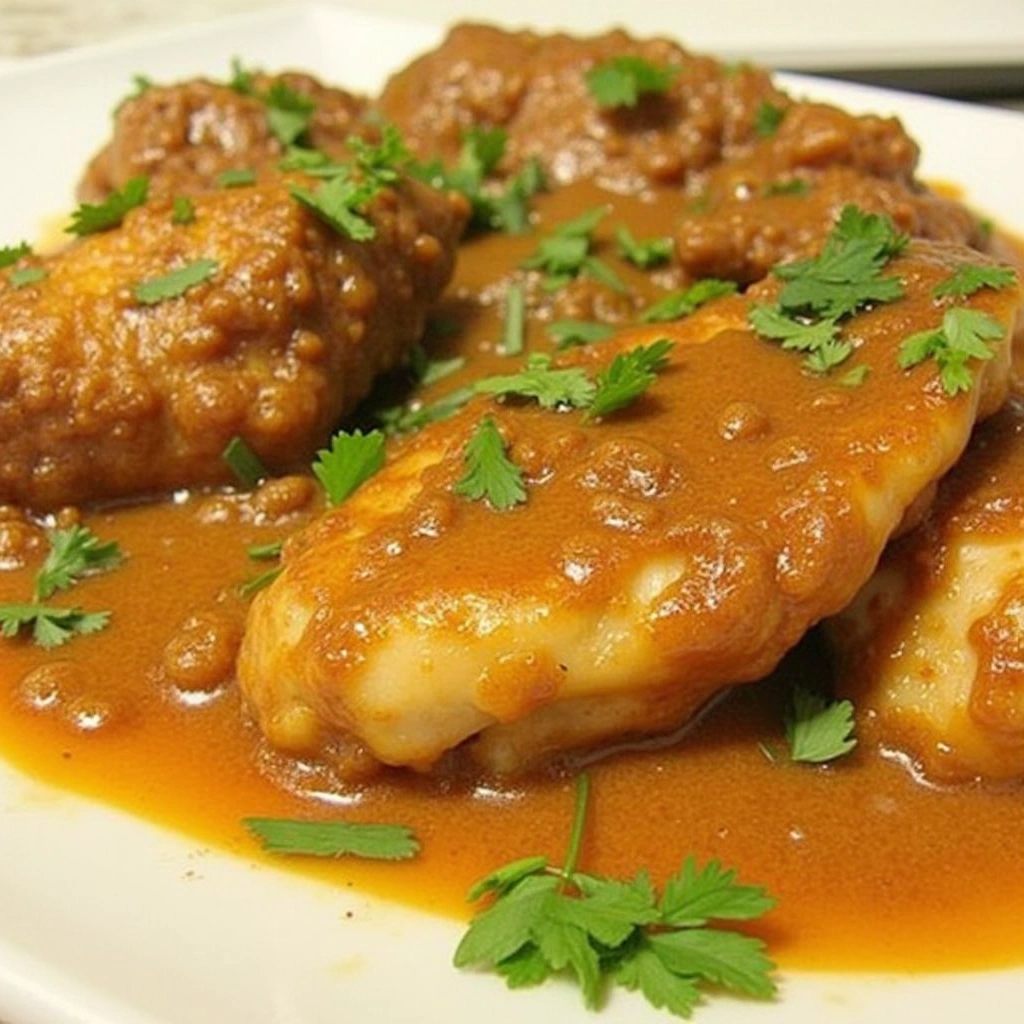Chicken Marsala is a beloved dish often associated with Italian-American cuisine. Its tender chicken, rich Marsala wine sauce, and earthy mushrooms make it a favorite in homes and restaurants alike. However, its name occasionally causes confusion, leading some to wonder if it has ties to Indian cuisine. This misconception arises due to the similarity between “Marsala,” referring to the wine used in the dish, and “masala,” which denotes a blend of spices commonly used in Indian cooking. Let’s dive into the origins and cultural context of Chicken Marsala to clarify its roots and its relationship to Indian cuisine.
The Historical Roots of Chicken Marsala
Origin in Sicilian Cuisine
Chicken Marsala’s roots trace back to Sicily, an island rich in culinary heritage. The dish takes its name from Marsala wine, a fortified wine produced in the region. Introduced in the late 18th century, Marsala wine was initially created for trade and export but quickly became a staple in Sicilian kitchens. Its unique combination of nutty, slightly sweet, and caramelized flavors made it a versatile ingredient in both savory and sweet dishes.
In Sicily, Marsala wine was often used to enhance the natural flavors of local ingredients. Chefs would deglaze pans with Marsala to create sauces that complemented meat, seafood, and vegetables. Chicken Marsala, in particular, became a popular way to showcase the wine’s complexity. The dish combined seared chicken with a sauce made from Marsala wine, mushrooms, garlic, and herbs, creating a harmonious blend of flavors that highlighted Sicily’s culinary ingenuity.
Marsala Wine in Sicilian Culinary Traditions
Marsala wine holds a significant place in Sicilian culture. Its production process, which involves fortifying the wine with brandy, results in a product that is both durable and flavorful. Sicilians embraced Marsala not only for its taste but also for its versatility in cooking. It became a defining element of regional cuisine, often paired with proteins like chicken or veal to create dishes that balanced richness and acidity.
Adaptation in America
When Italian immigrants brought their culinary traditions to America, they adapted their recipes to incorporate locally available ingredients. Chicken Marsala evolved during this time, blending old-world techniques with new-world practicality. Chefs in America refined the dish, using a creamier Marsala sauce and introducing butter and heavy cream for added richness. This adaptation gave rise to the Chicken Marsala we recognize today: an Italian-American classic that remains a staple on restaurant menus.
Is There an Indian Connection?
Why the Confusion?
The confusion between Chicken Marsala and Indian cuisine largely stems from the dish’s name. The word “Marsala” refers to the wine used in the recipe, but it bears a striking resemblance to “masala,” a term used in Indian cooking to describe a blend of spices. This linguistic similarity often leads people to associate Chicken Marsala with Indian cuisine, especially since both feature bold, flavorful sauces.
Additionally, Indian dishes like chicken tikka masala or butter chicken also incorporate tender chicken pieces in rich, flavorful sauces. This similarity in presentation reinforces the misconception that Chicken Marsala might have Indian origins. However, while both cuisines emphasize flavor and balance, their methods and ingredients differ significantly.
The Role of Spices and Sauces
Indian cuisine is known for its use of masalas, which are complex spice blends that form the foundation of many dishes.
Masalas typically include ingredients like cumin, coriander, turmeric, and garam masala, creating bold, aromatic profiles.
These spices contrast with the ingredients in Chicken Marsala, which relies on the nuttiness of Marsala wine, the creaminess of heavy cream, and the earthiness of mushrooms.
While both cuisines celebrate the use of sauces, their techniques diverge. Chicken Marsala’s sauce is created by deglazing the pan with Marsala wine and reducing it with cream, resulting in a velvety texture. In contrast, Indian masala sauces often involve simmering a tomato-based or yogurt-based mixture with spices, creating a spicier and more robust flavor profile.
Understanding Marsala vs. Masala
The key distinction lies in the terms themselves. “Marsala” refers specifically to the Sicilian wine that defines the flavor of Chicken Marsala. In contrast, “masala” is a Hindi word meaning “spice blend,” which plays a central role in Indian cooking. While the names sound similar, they represent entirely different culinary concepts.
It is also worth noting that Chicken Marsala has no historical ties to Indian cuisine. Its origin and development are firmly rooted in Sicilian and Italian-American traditions.
The similarities in flavor presentation—such as the use of sauces and rich seasonings—are coincidental rather than indicative of shared heritage.
Chicken Marsala is a testament to the rich culinary heritage of Sicily and the adaptability of Italian-American cooking. Although it shares some visual and conceptual similarities with Indian masala dishes, its roots and flavors are entirely distinct. By understanding these differences, we can appreciate both cuisines for their unique contributions to the global culinary landscape.
Culinary Comparisons Between Chicken Marsala and Indian Cuisine
Chicken Marsala and Indian masala dishes may appear similar due to their rich sauces and use of chicken as the main protein.
However, their ingredients, flavor profiles, and cooking techniques reveal the distinct culinary traditions that define them.
Ingredients and Flavor Profiles
Chicken Marsala
Chicken Marsala originates from Sicilian cuisine and heavily relies on the use of Marsala wine, a fortified wine that adds depth and sweetness to the dish.
Its ingredients include:
Marsala wine: The star of the dish, known for its nutty and slightly sweet flavor.
Mushrooms: Add earthiness and a meaty texture.
Shallots and Garlic: Create a mild aromatic base.
Heavy Cream: Provides a rich and velvety texture to the sauce.
Chicken: Typically boneless, skinless chicken breasts are used for tenderness.
The flavor profile of Chicken Marsala is rich, nutty, and slightly sweet. The Marsala wine imparts a caramelized depth, while the mushrooms and cream balance the dish with earthiness and luxury.
Indian Masala Dishes
Indian masala dishes, such as chicken tikka masala or butter chicken, are defined by their bold and aromatic spice blends. Common ingredients include:
Garam Masala: A blend of warm spices like cinnamon, cloves, and cardamom.
Turmeric: Adds an earthy bitterness and a vibrant golden hue.
Cumin and Coriander: Provide warmth and depth.
Tomatoes: Form the base of the sauce, adding acidity and sweetness.
Yogurt or Cream: Used for marination or to soften the intensity of the spices.
The flavor profile of Indian masala dishes is spicy, earthy, and highly aromatic. The spices create layers of complexity, with the sauce delivering heat, tanginess, and a hint of sweetness.
Key Differences
While Chicken Marsala emphasizes simplicity with a handful of rich ingredients, Indian masala dishes rely on an extensive array of spices for their bold flavors.
Marsala wine defines Chicken Marsala, while spice blends are central to Indian cuisine.
The use of cream in Chicken Marsala leans toward a delicate sweetness, contrasting with the robust, spiced nature of Indian sauces.
Cooking Techniques
Chicken Marsala
The preparation of Chicken Marsala showcases the elegance of Italian and Sicilian cooking. Key techniques include:
Pan-Searing: Lightly dredge the chicken breasts in flour and pan-sear them to achieve a golden crust. This step enhances both the flavor and texture of the chicken.
Deglazing with Wine: Deglaze the pan with Marsala wine immediately after searing the chicken. This technique lifts the browned bits, adding a rich depth of flavor to the dish.
Cream-Based Sauces: Create a velvety and luxurious sauce by reducing Marsala wine with chicken broth and heavy cream.
This method focuses on minimal ingredients, allowing each component to shine while creating a balance between richness and acidity.
Indian Masala Dishes
Indian masala dishes employ more intricate techniques, reflecting the complexity of Indian cooking. Common methods include:
Pan-Searing: Lightly dredge the chicken breasts in flour and pan-sear them to create a golden crust. This step enhances both flavor and texture.Deglazing with Wine: Use Marsala wine to deglaze the pan after searing the chicken. This process lifts the browned bits, adding depth to the flavor.Cream-Based Sauces: Reduce the Marsala wine with chicken broth and heavy cream to create a velvety and luxurious sauce.
This layering creates depth and nuance in the dish.
Indian cooking techniques often prioritize the gradual development of flavors, contrasting with Chicken Marsala’s quick, high-heat methods.
Distinct Regional Influences
Chicken Marsala’s cooking style reflects the simplicity and efficiency of Sicilian cuisine, where the focus is on enhancing fresh ingredients. In contrast, Indian masala dishes highlight the richness and diversity of Indian spices, with each region contributing its own unique variations.
FAQs Section
Is Chicken Marsala an Indian Dish?
No, Chicken Marsala is not an Indian dish. Its origins lie in Sicilian cuisine, where it was created using Marsala wine, a fortified wine produced in the region. Over time, the recipe was adapted in the United States, becoming a staple in Italian-American cooking. The dish’s flavors and preparation techniques align closely with Italian culinary traditions rather than Indian ones.
Why Does Chicken Marsala Sound Like an Indian Dish?
The confusion arises from the similarity in names between “Marsala” and “masala.” While Marsala refers to the wine used in the dish, masala is a term in Indian cuisine that describes a blend of spices used to season food. This linguistic overlap, combined with the use of rich sauces in both cuisines, often leads to the misconception that Chicken Marsala has Indian origins.
What is the Difference Between Chicken Marsala and Indian Chicken Masala?
The primary difference lies in the ingredients and flavor profiles. Chicken Marsala features a sauce made with Marsala wine, mushrooms, and heavy cream, creating a rich, nutty, and slightly sweet taste. In contrast, Indian chicken masala relies on aromatic spices such as garam masala, cumin, and turmeric, often combined with a tomato-based sauce. The resulting flavor is spicy, earthy, and aromatic, showcasing the bold character of Indian cuisine.
Can Chicken Marsala Be Adapted with Indian Spices?
Yes, Chicken Marsala can be customized with Indian spices to create a fusion dish. Adding garam masala, cumin, or coriander to the sauce can introduce an Indian twist while still retaining the dish’s original character. This fusion approach allows you to enjoy the best of both culinary worlds, combining the creaminess of Chicken Marsala with the bold flavors of Indian spices.
Conclusion
The Global Influence of Chicken Marsala
Chicken Marsala stands as a shining example of the blending of culinary traditions. Its origins in Sicily reflect the ingenuity of incorporating Marsala wine into cooking, creating a dish that is both rich and nuanced. As the recipe traveled to America, it evolved into a hallmark of Italian-American cuisine, showcasing the adaptability of culinary practices across cultures.
Clarifying Its Distinction from Indian Cuisine
While the name Chicken Marsala may cause some confusion due to its similarity to “masala” in Indian cuisine, the two are fundamentally distinct. Marsala refers to the Sicilian wine integral to the dish, while masala signifies the spice blends that define Indian cooking. By understanding these differences, we can dispel misconceptions and appreciate the unique attributes of each cuisine.
Embracing Culinary Curiosity and Adaptations
Cultural exchange and curiosity often lead to delightful adaptations, such as blending Chicken Marsala’s creamy sauce with Indian spices for a fusion twist. These experiments not only highlight the versatility of both cuisines but also celebrate their shared emphasis on flavor and innovation.
In exploring and understanding dishes like Chicken Marsala, we deepen our appreciation for the diverse culinary traditions that connect us, inspiring creativity and enjoyment at the table.

